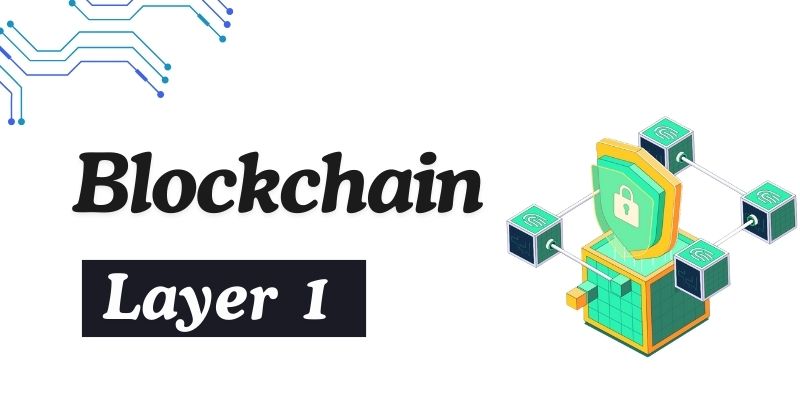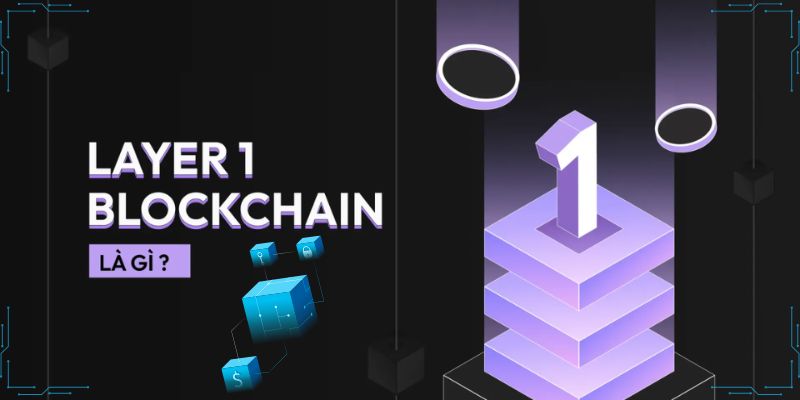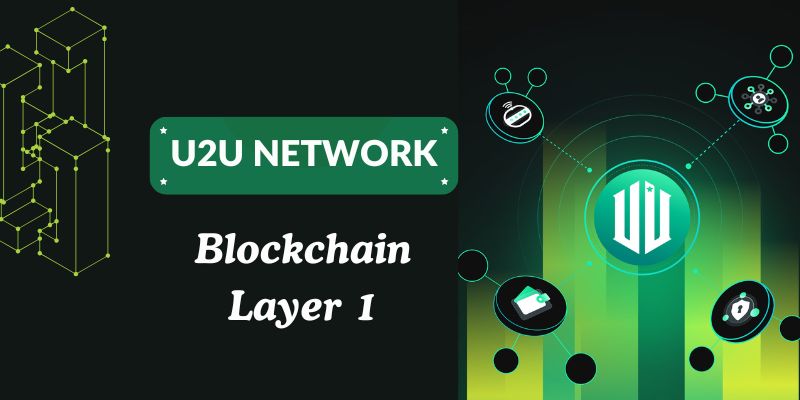Blockchain Layer 1 is the foundational layer of blockchain networks, ensuring security, transparency, and scalability. By handling core functions like transaction processing and validation, it forms the backbone of decentralized applications. In this article, we explore how Blockchain Layer 1 builds secure and scalable systems for the future.
What is Blockchain Layer 1?
A Layer 1 blockchain refers to the base-level blockchain that directly handles the core operations of the network. It includes the underlying consensus mechanism, data structure, and the primary protocol that ensures all participants in the network agree on the state of the blockchain.
Layer 1 blockchains do not rely on any external infrastructure, which distinguishes them from Layer 2 solutions (like the Lightning Network or rollups), which are designed to address specific scalability issues by building on top of existing Layer 1 networks.

This base layer ensures that every transaction on the network is secure, immutable, and verifiable, making it a crucial component for the development of blockchain ecosystems. Popular examples of Blockchain Layer 1 networks include Bitcoin, Ethereum, and Solana. Each of these blockchains has its unique consensus mechanism, tokenomics, and scalability features, but all serve as foundational technologies for their respective ecosystems.
Key Features of Blockchain Layer 1
Distributed Ledger Technology (DLT)
A core feature of Blockchain Layer 1 is its use of Distributed Ledger Technology (DLT). DLT allows the blockchain to store transaction data across a distributed network of nodes, ensuring that no single entity has control over the ledger. This decentralized nature eliminates the need for intermediaries, making transactions secure and transparent.
Moreover, because the ledger is immutable, once data is recorded on the blockchain, it cannot be altered or deleted. This creates a tamper-proof record that all participants in the network can trust, contributing to the security and transparency of the system.
Consensus Mechanisms
Blockchain Layer 1 networks use consensus mechanisms to validate transactions and agree on the state of the blockchain. Two of the most common consensus algorithms are Proof of Work (PoW) and Proof of Stake (PoS).
- Proof of Work (PoW): Bitcoin uses PoW, where miners solve complex mathematical puzzles to validate transactions and add new blocks to the blockchain. This process requires significant computational power but ensures the network’s security.
- Proof of Stake (PoS): Ethereum transitioned to PoS with the launch of Ethereum 2.0, where validators are chosen to confirm transactions based on the number of tokens they hold and are willing to stake as collateral. PoS is considered more energy-efficient than PoW and offers greater scalability.
Both consensus mechanisms ensure that Blockchain Layer 1 networks remain secure, decentralized, and resistant to malicious attacks.
Native Tokens
Each Blockchain Layer 1 network has its own native token used to pay for transaction fees and incentivize network participants. For example, Bitcoin uses BTC, Ethereum uses ETH, and Binance Smart Chain uses BNB. These tokens play a critical role in network operations, as they are required to execute transactions, smart contracts, and other network activities.
The native token also serves as an incentive for miners or validators to maintain the network. Without these incentives, participants would have no motivation to secure the network, leading to potential vulnerabilities.
Scalability and Performance
While Blockchain Layer 1 provides the foundational security and functionality for blockchain networks, scalability has been a longstanding challenge. As the number of users and transactions on the network grows, Layer 1 blockchains may experience slower processing speeds and higher transaction fees. This is particularly evident in networks like Ethereum, where congestion during periods of high demand has led to slow transaction times and increased gas fees.
To address these scalability challenges, many Layer 1 blockchains are exploring various solutions, including the implementation of sharding, layer 2 solutions, and improvements to consensus mechanisms. These efforts aim to increase throughput, reduce transaction costs, and ensure that the blockchain can handle the growing demands of a global user base.

Challenges Faced by Layer 1 Blockchains
Despite their importance, Layer 1 blockchains face several challenges that can hinder their scalability, efficiency, and overall performance. These challenges include:
1. Scalability
Scalability remains one of the most significant challenges for Layer 1 blockchains. As the number of users and transactions on the network grows, the blockchain may struggle to handle the increased demand. For example, Ethereum has faced network congestion and high gas fees during times of heavy usage, making it difficult to scale efficiently. Many Layer 1 blockchains are working on solutions to improve scalability, such as Ethereum’s transition to Ethereum 2.0, which will implement Proof of Stake and sharding to increase throughput.
2. Energy Consumption
Layer 1 blockchains that use Proof of Work (like Bitcoin) are often criticized for their high energy consumption. Mining requires significant computational power, leading to substantial electricity usage, which has raised concerns about the environmental impact of such blockchains. The transition to Proof of Stake in networks like Ethereum 2.0 aims to mitigate this issue by reducing the energy required to secure the network.
3. Transaction Fees
During periods of network congestion, transaction fees can spike significantly on Layer 1 blockchains. This can make it prohibitively expensive to use the blockchain, especially for small transactions. Ethereum, for example, has experienced high gas fees at times of increased network demand. Solutions like Layer 2 scaling (e.g., rollups) and Ethereum’s upcoming upgrades are designed to help alleviate this issue.
The Importance of Blockchain Layer 1 in Secure and Scalable Systems
Blockchain Layer 1 plays a vital role in creating secure and scalable blockchain networks. Its core functionalities—transaction processing, consensus validation, and ledger maintenance—form the bedrock for decentralized ecosystems. By using decentralized consensus mechanisms and DLT, Blockchain Layer 1 ensures that data is secure and tamper-resistant, fostering trust in the network.
Furthermore, Blockchain Layer 1 enables the creation of decentralized applications (dApps) and smart contracts, which rely on the blockchain’s immutability and security to execute without third-party intervention. This has opened up new possibilities for industries such as finance, supply chain management, healthcare, and more, as businesses can leverage the power of decentralization to create secure and efficient systems.
Layer 1 vs. Layer 2: Scalability Solutions
While Blockchain Layer 1 provides the core functionality for blockchain networks, scalability remains a significant concern, especially as transaction volumes increase. To address these limitations, Layer 2 solutions have been developed to enhance the scalability and efficiency of Layer 1 networks.
Layer 2 solutions, such as state channels and rollups, are built on top of Blockchain Layer 1 and allow for faster, cheaper transactions by offloading some of the transaction processing off-chain. These solutions aim to reduce congestion and improve transaction throughput, which ultimately benefits Layer 1 networks by alleviating pressure on their core systems.

Notable Layer 1 Blockchain Examples
Several prominent Layer 1 blockchains serve as the backbone of the blockchain ecosystem, each catering to different use cases and solutions. Below are some notable examples that highlight their unique features and functionalities:
Bitcoin (BTC)
Bitcoin is the first and most well-known Layer 1 blockchain. It serves as a decentralized digital currency and is often referred to as “digital gold.” Bitcoin uses the Proof of Work (PoW) consensus mechanism to ensure the security and immutability of its transactions. Bitcoin is primarily designed to function as a store of value, allowing individuals to transfer and store wealth without intermediaries. Its focus is on security, decentralization, and immutability, making it one of the most secure blockchain networks in the world.
- Primary Use Case: Digital currency and store of value.
- Key Feature: High security, immutability, and decentralization.
Ethereum (ETH)
Ethereum is a Layer 1 blockchain known for enabling the creation and execution of smart contracts and decentralized applications (dApps). It serves as the foundation for decentralized finance (DeFi), non-fungible tokens (NFTs), and many other decentralized projects. Ethereum initially used Proof of Work (PoW) but is transitioning to Proof of Stake (PoS) to improve scalability and energy efficiency with Ethereum 2.0. Ethereum’s smart contract capabilities have made it the most widely used platform for building decentralized applications.
- Primary Use Case: Smart contracts, decentralized applications (dApps), DeFi, and NFTs.
- Key Feature: Smart contract functionality and developer ecosystem.
Solana (SOL)
Solana is a high-performance Layer 1 blockchain designed for scalability, speed, and low transaction costs. It utilizes a unique Proof of History (PoH) combined with Proof of Stake (PoS) to achieve fast and efficient transaction processing. Solana can handle thousands of transactions per second (TPS), making it ideal for high-throughput applications such as DeFi and gaming. Its low fees and quick processing times make it a popular choice for developers and users seeking an efficient blockchain network.
- Primary Use Case: High-throughput decentralized applications (dApps), DeFi, gaming.
- Key Feature: Speed, scalability, and low transaction costs.
Cardano (ADA)
Cardano is a Layer 1 blockchain that emphasizes energy-efficient Proof of Stake (PoS) and formal verification to ensure the correctness of smart contracts. It was designed with a research-driven approach and focuses on scalability, sustainability, and security. Cardano aims to provide a secure and sustainable platform for building decentralized applications while prioritizing energy efficiency. It is particularly known for its rigorous academic and peer-reviewed development process.
- Primary Use Case: Decentralized applications (dApps), smart contracts, and sustainable blockchain solutions.
- Key Feature: Energy-efficient PoS and formal verification for smart contracts.
Polkadot (DOT)
Polkadot is a Layer 1 blockchain that focuses on interoperability between different blockchains. It allows multiple blockchains to communicate, share data, and transfer assets seamlessly through its relay chain and parachains. Polkadot’s architecture enables secure, cross-chain transactions, which is crucial for building a more interconnected and efficient blockchain ecosystem. By enabling different blockchains to work together, Polkadot fosters collaboration across various projects and helps solve the fragmentation problem in the blockchain space.
- Primary Use Case: Cross-chain communication, interoperability between blockchains.
- Key Feature: Multi-chain architecture and interoperability.
These Layer 1 blockchains are foundational to the development of blockchain technology, each providing unique solutions to the challenges of scalability, security, and decentralization. Whether it’s Bitcoin for secure, peer-to-peer transactions, Ethereum for decentralized applications, or Solana and Cardano for scalability and efficiency, each blockchain has its own strengths and plays a pivotal role in the overall blockchain ecosystem.
U2U Network: A High-Performance Blockchain Layer 1 Solution
The U2U Network is an innovative blockchain project that harnesses the power of Layer 1 technology to deliver scalable and high-performance solutions for various industries. Designed with performance and efficiency at its core, the U2U Chain is a groundbreaking blockchain platform that can process up to 500,000 transactions per second (TPS), with a block completion time of just 350 milliseconds. These remarkable capabilities position U2U as one of the fastest and most efficient blockchain networks in the market today.
Key Features of the U2U Network
1. High Transaction Throughput
The U2U Chain is specifically built to handle 500,000 transactions per second, far surpassing the transaction throughput of many established Layer 1 blockchains such as Bitcoin or Ethereum. This high throughput makes the U2U Network ideal for environments requiring high-frequency transactions, such as decentralized finance (DeFi) platforms, e-commerce applications, and gaming ecosystems.
2. Fast Block Completion Time
With a block completion time of only 350 milliseconds, the U2U Chain is able to ensure that transactions are processed almost in real-time. This incredibly fast transaction speed is critical for applications where quick settlement times are essential, such as in financial services and real-time trading platforms. The low latency enhances the overall user experience, making U2U a suitable solution for businesses that require efficient and timely data processing.
3. Scalability for Various Applications
The high performance of the U2U Network allows it to scale effortlessly to meet the demands of both small-scale applications and large-scale enterprises. Whether it’s supply chain management, financial services, smart contracts, or enterprise resource planning (ERP), the U2U Network can support a diverse range of use cases with its powerful infrastructure.
4. Security and Decentralization
Like other Layer 1 blockchains, the U2U Network emphasizes security and decentralization. The network is designed to ensure that all transactions are transparent and verifiable, providing an immutable ledger of data. U2U also implements a robust consensus mechanism that maintains a high level of network security, while ensuring decentralization to prevent single points of failure and malicious attacks.
5. Energy-Efficient Consensus Mechanism
In line with the growing concern over the environmental impact of blockchain networks, the U2U Network utilizes an energy-efficient consensus mechanism. Unlike traditional Proof of Work (PoW) systems, which require massive amounts of computational power, U2U uses a more sustainable approach to validate transactions while maintaining the integrity of the network.
Applications of U2U Network
The performance and scalability of the U2U Network make it an attractive solution for a wide array of applications:
- Financial Services: With high transaction throughput and low latency, the U2U Network can support high-frequency trading platforms, cross-border payments, and real-time settlement systems. It could also be used in decentralized finance (DeFi) platforms to facilitate quick and secure financial transactions.
- Supply Chain Management: The U2U Chain’s speed and scalability make it well-suited for tracking goods and assets in supply chains, ensuring transparency and security at every stage of production, distribution, and delivery. Real-time tracking and auditing can be facilitated through smart contracts on the blockchain.
- Gaming: U2U’s ability to handle a large volume of transactions quickly is ideal for blockchain-based gaming platforms where in-game assets, tokenization, and microtransactions need to be processed at a rapid pace.
- Internet of Things (IoT): The U2U Network can provide the underlying infrastructure for IoT applications, where multiple devices need to exchange data in real-time. The network’s scalability and low latency make it an excellent fit for IoT networks requiring fast communication and secure data storage.
- Enterprise Solutions: With its high-performance capabilities, the U2U Network is also suited for enterprise-level applications, such as enterprise resource planning (ERP), cloud computing, and data management systems, where large volumes of data need to be processed quickly and securely.
In addition to its high throughput, U2U utilizes the Helios consensus mechanism, which combines virtual voting and gossip protocols to ensure decentralization and security. This makes U2U a promising blockchain network that is built on the foundation of Blockchain Layer 1 technology but optimized for scalability and efficiency.
Check out more information on the Digicash Blog!
